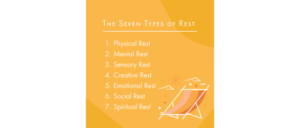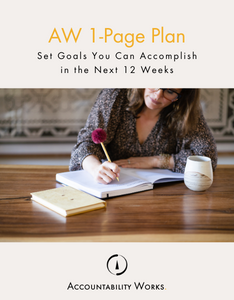You’ve been getting the message that rest is important. But how are you doing at making rest a habit? Here are some simple strategies for prioritizing rest and your well-being.
1. Identify What Type of Rest You Need
Last year, I shared this graphic on the 7 Types of Rest that was inspired by this article that appeared on the ideas.ted.com website.

Knowing what type of rest you need is helpful because then you can start to build habits around the type of rest you need. For instance, a need for emotional rest might require setting boundaries in your relationships while sensory rest might require that you take regular breaks from screens. What type of rest do you need?
2. Figure out how you rest best
So many of our clients work on rest as part of their weekly commitments. However, it takes time to figure out how to rest. Many of our clients are wired to move quickly and to fill up their time and if they aren’t doing that they feel a certain amount of discomfort. So rest for you might not be taking a nap. It might mean a brisk walk outside. Time with friends or family. Alone time. Or time spent pursuing a creative project. In other words, rest is individual. For instance, one of our client’s version of rest is reading a novel while another client’s version of rest is writing. They are literally opposite actions and yet each person finds them relaxing.
Here are some questions to ask yourself about rest:
- Do you get enough good quality sleep?
- Do you have any unscheduled time during your day?
- Do you have time away from work and screens?
- Do you spend time in nature?
- Do you have enough time with family and friends or is it too much and you need more alone time?
- Do you take time to breathe, be still or meditate?
3. Start with Easy Rest Habits
The point is to look at rest from multiple viewpoints and to see where you can put into place easy daily or weekly habits of rest. Our clients are super creative and varied in the way they approach rest. Here are some of the commitments we’ve seen recently: tracking sleep, adding in blocks of me-time, taking a wait period before saying yes to an invitation, reading for pleasure. The key is to think about how you can easefully work these habits into your day or week.
4. Adjust as Needed
Treat figuring out what rest is best for you and how to incorporate good rest habits as an ongoing experiment. If what you thought would be helpful isn’t, let it go. If something is working build on it. The important thing is that you are prioritizing and aware of your levels of energy and when and in what areas you feel depleted. Remember that burnout is optional and you can choose differently.
Applying these steps is incredibly simple. What type of rest do you need? Based on your answer, how do you address that need? What is the simplest first step or habit you can put into place? How is this step or habit working? What if any changes do I need to make?



